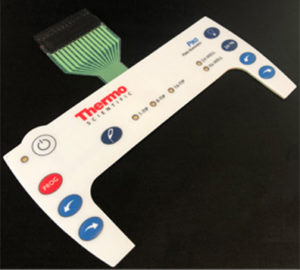The Case Against Printed Silver Circuitry: Embedded Components
We recently had a customer approach us experiencing issues with one of their printed silver circuit membrane switch designs. The customer sent us some samples for our analysis and it was found that the LEDs would function as expected in a flat state but when the tail was pulled back or the keypad flexed, the parts exhibited enough internal force to also flex the LED causing the LED to either fail and/or flicker in some cases. It was then determined that the LED issues were caused by the silver epoxy fracturing where it joins the printed silver ink circuit trace. It wasn’t the LEDs that were failing, but actually the method in which the LEDs were applied to the circuit that was ultimately failing.
When first designing this keypad assembly, the available flexible circuit technology at the time was printing silver ink on polyester film and affixing LEDs to the silver circuit using a silver epoxy paste or glue. Although, printed silver is still a common method even to this day, it does lack some robustness and does not always achieve the same results for all customers. There are a host of reasons why it can fail, but when it does it is best to upgrade to a more robust design (polyimide circuitry). With the availability of cost effective copper on Kapton flex circuits, we are now able to provide soldered LEDs which are far more reliable than having to rely on an epoxy assembled LED. Being able to traditionally solder LEDs provides an infinitely more reliable part as both the joint and the adhesion of the copper to the polyimide (Kapton) base substrate are much more durable.
CSI utilizes copper flex circuitry on many similar keypad assemblies that are used in the automotive industry, medical devices, military, marine, etc. Many of which reside in harsh environments and in most cases have withstood and passed extensive testing by our customers before entering production. It is a time-proven and tried-and-true design for CSI and one we have been successfully utilizing for a decade.

